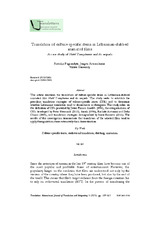Mostrar el registro sencillo del ítem
Translation of Culture-Specific Items in Lithuanian-Dubbed Animated Films. A Case Study of “Hotel Transylvania” and Its Sequels
| dc.contributor.author | Pagrandytė, Rozalija | |
| dc.contributor.author | Astrauskienė, Jurgita | |
| dc.date.accessioned | 2023-06-26T15:17:03Z | |
| dc.date.available | 2023-06-26T15:17:03Z | |
| dc.date.issued | 2021 | |
| dc.identifier.issn | 2605-2954 | |
| dc.identifier.uri | http://hdl.handle.net/10396/25619 | |
| dc.description.abstract | This article examines the translation of culture-specific items in Lithuanian-dubbed animated film Hotel Transylvania and its sequels. The study seeks to establish the prevalent translation strategies of culture-specific items (CSIs) and to determine whether Lithuanian translators tend to domesticate or foreignise. The study relies on the definition of CSIs provided by Javier Franco Aixelá’s (1996), the categorisations of CSIs developed by Peter Newmark (2010), Aixelá (1996), Rachele Antonini and Delia Chiaro (2005), and translation strategies distinguished by Irene Ranzato (2016). The results of this investigation demonstrate that translators of the selected films tend to apply foreignization more extensively than domestication. | es_ES |
| dc.format.mimetype | application/pdf | es_ES |
| dc.language.iso | eng | es_ES |
| dc.publisher | UCOPress | es_ES |
| dc.rights | https://creativecommons.org/licenses/by/3.0/ | es_ES |
| dc.source | Transletters. International Journal of Translation and Interpreting 5, 139-162 (2021) | es_ES |
| dc.subject | Culture-specific items | es_ES |
| dc.subject | Audiovisual translation | es_ES |
| dc.subject | Dubbing | es_ES |
| dc.subject | Animation | es_ES |
| dc.title | Translation of Culture-Specific Items in Lithuanian-Dubbed Animated Films. A Case Study of “Hotel Transylvania” and Its Sequels | es_ES |
| dc.type | info:eu-repo/semantics/article | es_ES |
| dc.relation.publisherversion | https://www.uco.es/ucopress/ojs/index.php/tl/index | es_ES |
| dc.rights.accessRights | info:eu-repo/semantics/openAccess | es_ES |

